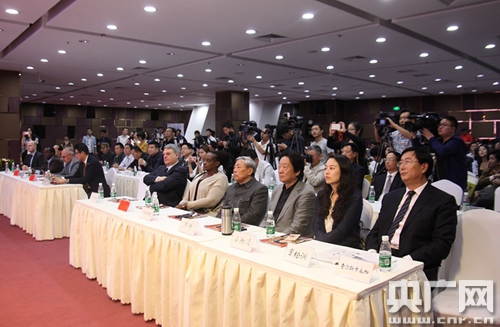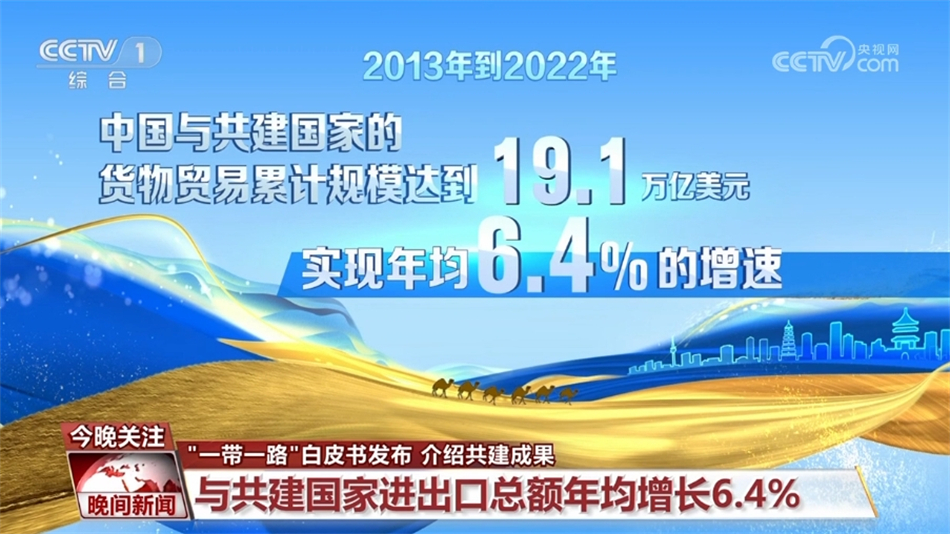New Era, New Journey And New Picture (Seventy Years Of Temperature And Progress To The North And South Of The Tianshan Mountains)——A Summary Of The High-Quality Development Achievements Of Xinjiang Uygur Autonomous Region
New Era, New Journey And New Picture (Seventy Years Of Temperature And Progress To The North And South Of The Tianshan Mountains)——A Summary Of The High-Quality Development Achievements Of Xinjiang Uygur Autonomous Region
The camel bells from a thousand years ago seemed to be still in my ears, and the long whistle sounded echoed on the Silk Road for a long time. Xinjiang, which is deeply located inland, has now become a core area and a hub area. Above the fertile fields, wheat waves rise and fall, and green gauze tents surge
The camel bells from a thousand years ago seemed to be still in my ears, and the long whistle sounded echoed on the Silk Road for a long time.
Xinjiang, which is deeply located inland, has now become a core area and a hub area. Above the fertile fields, wheat waves are undulating, and green gauze tents are pouring. "Xinjiang grain" adds heavy confidence to stabilize the Chinese bowl; under the blue sky and white clouds, silver eagles are soaring, and the Silk Road in the air turns the inland hinterland into an open highland; among the Gobi deserts, fans are like forests and photovoltaics are like seas, and green electricity injects strong momentum into high-quality development... More than 26 million children of all ethnic groups in Xinjiang work together and forge ahead, writing a new historical chapter on the new era and new journey.
Find positioning in serving and integrating into the new development pattern
In Horgos, Xinjiang, 35-year-old Yilizati Nigati is a "ferryman" of domestic cars. He drove a new domestic car out of the country, delivered it in Kazakhstan, and then returned on a multinational passenger bus. In Horgos, there are nearly 4,000 "ferrymen" of domestic cars like him. Li Hongfeng, deputy director of Horgos Customs, introduced that domestic cars are popular in the Central Asian market. From January to August this year, 237,000 vehicles were exported at the Horgos Port, an increase of 5.3% year-on-year.
At the Turgat Port in Xinjiang, Maimatijuma Sharbay's slack farming service is no longer idle. The port freight yard at the doorstep is full of traffic and requires a lot of labor, so he can make money at the doorstep. Relying on the Turgat Port and Ilkishtan Port, Wucha County, Xinjiang, has approved the opening of nearly 500 registered enterprises and requires thousands of workers every year.
Xinjiang, which has "five ports connected to eight countries and one road connected to Europe and Asia", has 19 ports approved by the State Council and opened to the outside world. Xinjiang consciously integrates the regional opening-up strategy into the overall layout of national opening-up to the west, continues to promote the deep, wide-field and all-round expansion of opening-up to the outside world, and creates a golden channel for Asia and Europe and a bridgehead for opening-up to the west.
Today, Xinjiang is opening up, and the global "circle of friends" is expanding and expanding. In 2024, the import and export of goods in Xinjiang was 434.16 billion yuan, surpassing the 200 billion yuan, 300 billion yuan and 400 billion yuan marks in 2022, 2023 and 2024 respectively. A big step a year, a new atmosphere will take place every year.
Xinjiang is not only a gateway for my country to open to the west, but also a treasure land with rich cultural heritage, magnificent mountains and rivers, and abundant energy and mineral resources, with huge development potential.
The quality and efficiency of development are improving. In the Junggar Basin in Xinjiang, the development landscape of "new oil and gas" is changing with each passing day. "This year we have achieved a historic leap again. The new comprehensive oil and gas equivalent of Xinjiang Oilfield Company will reach 20 million tons." Ding Chao, manager of the Development Department of China National Petroleum Xinjiang Oilfield Company, introduced, "In Xinjiang, the construction goal of the first national-level continental shale oil demonstration zone will be fully completed, the 'four 100 billion cubic meters' atmospheric zones are basically formed, the world's first ultra-heavy oil mining tower-type photothermal replacement demonstration project is put into operation, and the national science and technology special project - low-carbon zero-carbon oil and gas field demonstration project is accelerated."
The chain of the industry is extending. Naomao Lake is a small town in Yiwu County, Hami City. It used to be a small population and a remote land. Now it has gathered a large number of enterprises, and tens of thousands of skilled workers work here. Duan Xuan, Party Secretary of Xinjiang Guanghui Environmental Protection Technology Company, said: "Since coal mining, our industrial chain has been continuously expanded. Now, a billion-level green circular economy industrial chain integrating coal deep processing, bulk energy logistics and supporting services has been formed, providing services to dozens of enterprises inside and outside Xinjiang."
From the "bottom of the pocket" to the "bridgehead", from the main battlefield of poverty alleviation to the "fulcrum", "base" and "barrier", Xinjiang has achieved unprecedented achievements in economic and social development and improvement of people's livelihood. Data shows that Xinjiang's GDP increased from 749.947 billion yuan in 2012 to 2053.408 billion yuan in 2024, breaking the 2 trillion yuan mark for the first time, with an average annual growth rate of 7.0%; the per capita GDP increased from 33,495 yuan in 2012 to 78,660 yuan in 2024, and the current price increased by 1.3 times.
Solve the problem of grasping the problem of moving the whole body
At the junction of Wensu County and Wushi County in Aksu Prefecture, a "giant dragon" lies across the Kumarak River Valley - this is the world's highest record for the construction of concrete panel gravel dams with a maximum dam height of 247 meters.
On September 20, the Dashixia Water Conservancy Hub officially launched the gate storage of water, marking an important step towards the comprehensive benefits of irrigation, flood control, power generation, etc., this major infrastructure project in southern Xinjiang has taken an important step towards fully leveraging the comprehensive benefits of irrigation, flood control, power generation, etc. "After the project is completed, 3.42 billion cubic meters of water can be transferred to the Tarim River ecological annually, alleviating the water shortage problem of more than 8 million mu of irrigation areas downstream, and helping local people achieve high yields and increased income." Wang Fengbin, deputy chief engineer of the project, introduced.
On the edge of the Taklamakan Desert, there is an endless saline-alkali land. "80% of our fields are red dates, and drip irrigation saves about 20% of water than before. Everyone is very active." Chen Hong, a farmer from Hai'an Town, Tumushuke City, said.
From flooding to drip irrigation to popularization of drip irrigation, from "jogging water" in artificial drainage of gates and soil canals to automatic measurement of pipelined water transfer, farmers' water costs have been repeatedly reduced. At many seminars on high-quality development in Xinjiang, the needs put forward by cities and prefectures in various regions focus on "water". "As long as water is provided, we ensure the speed of development and the quality and efficiency of development."
A drop of water reflects the vicissitudes of Xinjiang: in 70 years, the irrigation area in Xinjiang has increased from 16.81 million mu at the beginning of the founding of New China to 99.17 million mu in 2024, and the grain yield per mu increased from less than 100 kilograms to 524.8 kilograms in 2024, ranking first in the country. Xinjiang has delivered an impressive and abundant yield report with 3% of the country's water resources.
In the vast rural land, rural centralized water supply projects have taken root. The 169,500-kilometer rural water supply pipeline is like capillaries, spread throughout the vast rural areas of Xinjiang. There are 54,600 kilometers of pipelines at or above the village level and 114,900 kilometers of pipelines in the village. The penetration rate of tap water in rural Xinjiang has reached 99%.
While striving to ensure water supply, Xinjiang people practice water conservation. In Karamay City, the rippling Karamay River passes through the city, and the Karamay people try their best to make full use of every drop of water. Gao Fuzhang, deputy director of Karamay Water Affairs Bureau, said: "From January to August this year, Karamay produced 45.498 million cubic meters of recycled water, reused 28.286 million cubic meters, with a reuse rate of 62%.
Do a good job in "water articles" and turn the Gobi Desert into good fields. Nowadays, you can not only see green oasis in the north and south of the Tianshan Mountains, but also smiley faces that are full of water. In addition, Xinjiang has also worked hard to grasp the key issues and deep-seated contradictions that affect social stability and long-term stability, ensure the continuous optimization of the business environment with the rule of law, accelerate the release of energy and resource potential, and focus on the "chess eye" to vigorously support the development of southern Xinjiang... Especially since the 18th National Congress of the Communist Party of China, Xinjiang has solved many problems that have been wanted to solve but have not been solved for a long time, and has accomplished many major things that have been wanted to do but have not been accomplished in the past, and has promoted historic changes in various undertakings in Xinjiang.
Promote fundamental, basic and long-term work that concerns long-term stability
Xinjiang fully implements the Party’s ethnic and religious policies and creatively carries out the “Ethnic Unity One Family” activity. People of all ethnic groups continue to enhance their feelings through coming and going, speaking, singing, gathering and chatting, and the “concentric circle” of national unity is getting bigger and bigger.
With the goal of enhancing identity, culture will be carried out in depth. At Luying Middle School in Yingjisha County, "classic recitation" has become a trend. Walking on campus, the recitation of "The Analects of Confucius", "The Book of Rites" and "The Tales of the Master" sounded from time to time. "We combine students' daily life and habits and give in an easy-to-understand explanation, so that traditional culture can be integrated with the core socialist values, integrate excellent traditional culture into students' daily life, and immerse children's hearts." Zhang Xiaoqian, a teacher who aided Xinjiang, said that Jining and Xinjiang also carried out 73 regular "five introductions" lectures on "five introductions" of Chinese studies, and 26,000 local people actively participated.
Taking the forging of a strong sense of community for the Chinese nation as the main line, various ethnic groups have extensive exchanges and integration. In Guyuanxiang Community, Urumqi City, brothers and sisters from all ethnic groups sang "My Motherland and Me" together. Like many communities in Xinjiang, this community is a multi-ethnic family. But everyone is not divided into ethnic groups. The elderly participate in instrumental choirs and Peking Opera interest classes together. The children study together in the Chinese studies class after school.
The development achievements benefit people's livelihood and unite people's hearts, and cadres and the masses have forged sincere friendship. In Qiaoerbo Village, Tielek Township, Postan, Wucha County, Xinjiang, the police station's "Horseback Police Service Team" came to the yurt of the herdsman Kurban Maimati, and brought him a brand new household registration book and vegetables and fruits purchased by him. "We have been riding a horse into the mountainous area and delivering services to the doorsteps of herders' homes for 6 years and will continue to persist," said police officer Gakupuwali Baikyaoli.
A touching story vividly interprets "hugging each other tightly like pomegranate seeds."
Today, Xinjiang has burst out vitality, full of motivation and potential, and is a stable, peaceful and vigorous atmosphere. People of all ethnic groups in Xinjiang are following the grand blueprint drawn by General Secretary Xi Jinping, uniting and moving forward bravely, and striving to write a chapter of Chinese-style modernization in Xinjiang.





